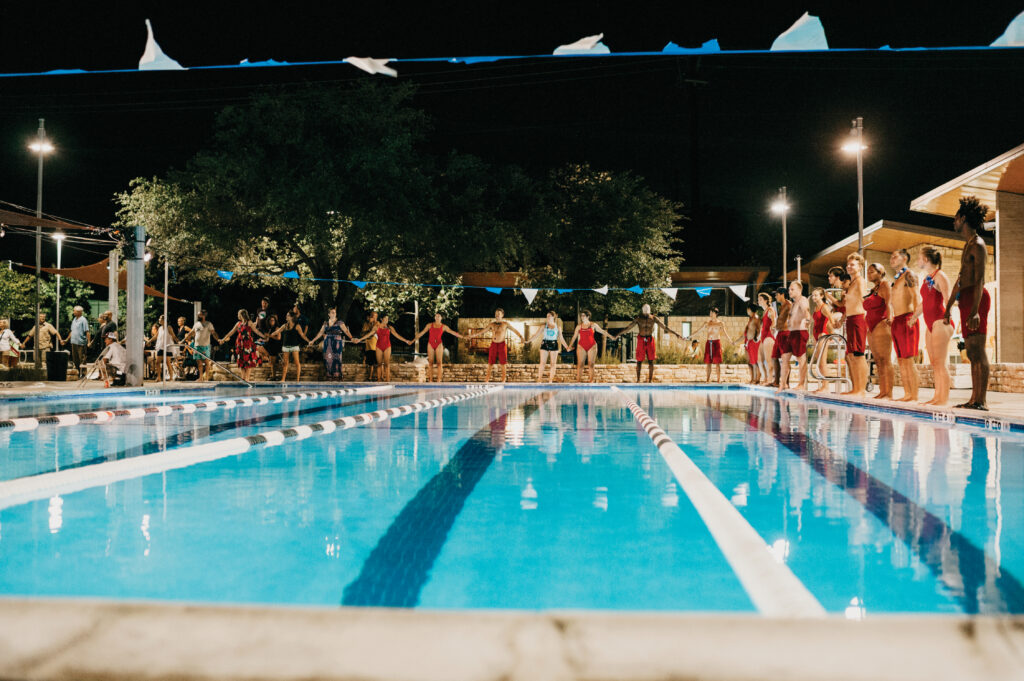
Community members tour the community garden at World Garden Commons tended by Growing Together during the Welcoming Week celebrations. The event included a meal prepared with produce from the garden, garden tours and local entertainment. World Garden Commons at Rabanus Park is the pilot site of The Fargo Project, in Fargo, North Dakota. Photo by Amu Production, 2016.
It has been 46 years since Joseph Beuys published his manifesto of Social Sculpture, I AM SEARCHING FOR FIELD CHARACTER (1973), stating straight-off:
Only on condition of a radical widening of definition will it be possible for art and activities related to art to provide evidence that art is now the only evolutionary-revolutionary power. Only art is capable of dismantling the repressive effects of a senile social system that continues to totter along the deathline: to dismantle in order to build A SOCIAL ORGANISM AS A WORK OF ART.
This move to understand society itself and social transformation as works of art has inspired countless artists since, and even before (Mierle Laderman Ukeles wrote her own Maintenance Art Manifesto 1969! over five years prior.) Despite nearly 50 years of demonstration to the contrary, socially engaged art—an umbrella term for many characterizations of shaping relationships and society as a form of art—faces routine questioning and even belligerence by the art world establishment on behalf of the product obsessed art market. Artists and administrators embody the cognitive dissonance of pushing the socio-political value of artists, while asking themselves quietly, “what can art really do?” We’ve seen this pushing of ideas from the top down, effectively art campaign-style “messaging” of progressive ideas passively through aesthetic experience, fails to produce action and political change simply because it fails to demand it of the viewer, and fails first to demand it of the artist.
However, in the world outside of the international art circuit, socially engaged artists and the incorporation of artists into policy initiatives and governmental agencies, and within their communities, is gaining traction where it matters most. Ironically, it’s sometimes policy wonks and bureaucrats who are likelier to embrace abstract notions of what art is and its potential, before the art world establishment. We see this in the growth of the creative placemaking field. Within communities, institutions, and the halls of government that we imagine as the defacto shapers of our social sculpture, artists have been creating meaningful, tangible, and measurable progress. This has been the focus of A Blade of Grass’s initiatives since conceiving of the Fellowship for Socially Engaged Art, now entering its sixth year, and basis of its newly released online guide to Municipal-Artist Partnerships, a free resource for artists and city agencies to understand the stakes and opportunities of this work.

My Park, My Pool, My City is a three-year artistic residency in partnership with the Austin’s Parks and Recreation Aquatics Division which began in 2017, activating and amplifying civic engagement around the future of Austin’s city pools. Photo by Jonica Moore.
Developed as a “relationship guide,” Municipal-Artist Partnerships emphasizes the relational, not transactional, quality of this artwork. The guide offers artists and their counterparts within a city agency valuable insight through tools, examples, and exercises designed to get each to see the work through the perspective of the other, test their assumptions and understanding, and enter these partnerships with better awareness of their dynamics, requirements, and potential. Within these arrangements, there are no passive “viewers” to the work, only collaborators within it. The outcomes can be sizable, whether it’s transforming the landscape and public space of a city, healing and moving beyond trauma and prejudice within systems, diverting youth from prison, optimizing residents’ access and experience with city services, or the wellbeing of those providing them. With each successful instance of sculpting a more sustainable, equitable, and just society, audiences are transformed into artists and political agents themselves. As Beuys continues in his manifesto, “This most modern art discipline – Social Sculpture/ Social Architecture will only reach fruition when every living person becomes a creator, a sculptor, or architect of the social organism. Only then […] would democracy be fully realized.” If mandating that everyone must be an artist feels a bit undemocratic, then maybe the more consensual version of social sculpture is that anyone who wants to be is an artist.
Art is a seemingly low stakes space that invites imagination, empathy, and action implemented over time, with the right context and community; the stakes rise until they become real world changes.
If you’re an artist, social engagement could be considered another dimension to work with: from 2D to 3D, to no longer representative, but reality. If you’re not an artist, but have an idea for some project that manifests in experimentation and boundary pushing to effect change to our institutions and landscapes, maybe you are an artist? Laurie Rojas points out in a 2010 Chicago Art Magazine essay, “…the problem is not the lack of conversation, it is the lack of a body politic that has the ability to mobilize for progressive social transformation…” This is precisely the aim of A Blade of Grass. We believe art, as a proposition, allows for distinct and important methods of change. A seemingly low stakes space that invites imagination, empathy, and action implemented over time, with the right context and community; the stakes rise until they become real world changes. With each socially engaged art work, each artist embedded within a sanitation department or police department, forcing the needle on more equitable, sustainable power dynamics and systems, the next art world is being built. It will include beautiful things, and tragic things, and well designed things, but these things will not exist to make all the ugly, disturbing, and poorly designed aspects of our society more palatable. It will replace them.
Kathryn McKinney is the Head of Content & Communications at A Blade of Grass.



